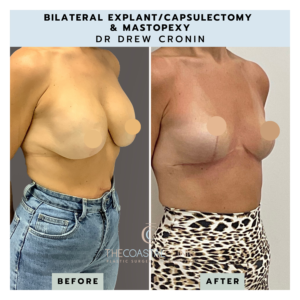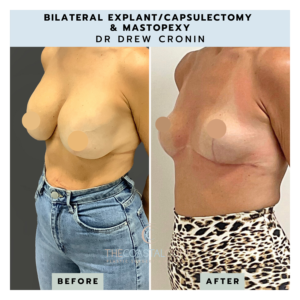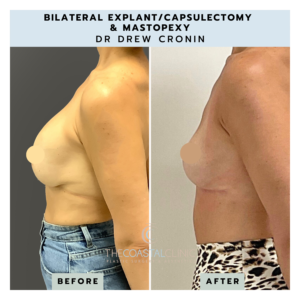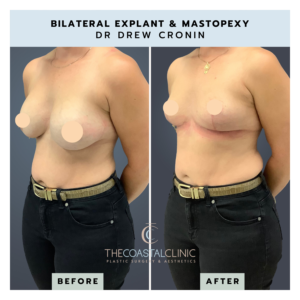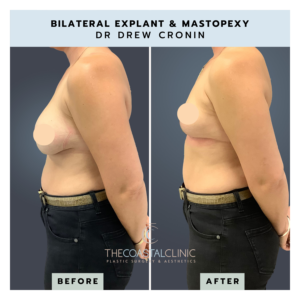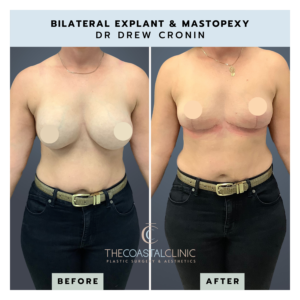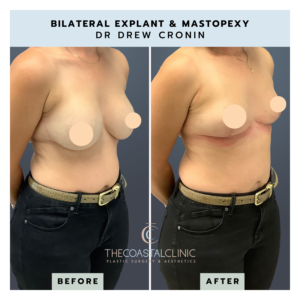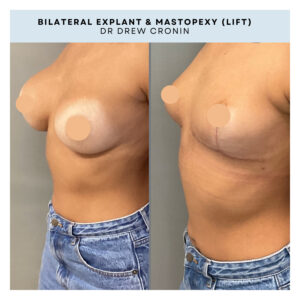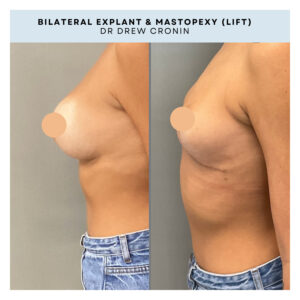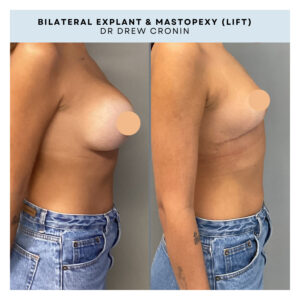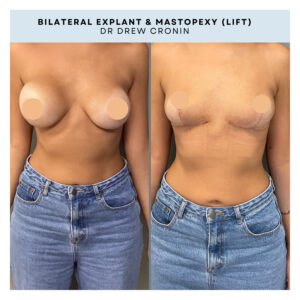
Explant Surgery (Implant Removal)
Many women with breast implants eventually decide to have them removed with or without replacing the implants. There are a variety of different reasons for making this decision. Other procedures that can performed simultaneously include fat grafting and a breast lift (mastopexy). A mastopexy may be required to address any sagging or excess skin that may result from the removal of the implants. Fat grafting or an implant may be required to restore volume.
Why do some patients choose to have implants removed?



Things to consider when choosing your implants
Lifestyle
Medical Reasons
Aesthetic Concerns
Health considerations
Breast Implant Removal: The Procedure
We’ve sat down with Dr Cronin to discuss some of the most commonly asked questions about Breast Implant Removal surgery.
- Why do women choose to have their implants removed?
- What to expect at your first consultation
- What is an En-Bloc
- What scarring should you expect when explanting?
- Recovering after surgery
- When can I return to exercise?
- How does the breast change after explant surgery?
Watch the video to learn about Breast Implant Removal with Dr Drew Cronin.
How is a breast implant removal procedure performed?
Incision
The surgeon makes an incision to access the implants. The incision location can vary, but it is often made along the same incision lines as the initial breast augmentation to minimise additional scarring. Common incision sites include:
- Along the inframammary fold (underneath the breast).
- Around the areola (the pigmented area surrounding the nipple).
- In the armpit (less common).
Implant Removal
Once the incision is made, the surgeon carefully removes the implants. If the patient has silicone implants that have ruptured, special care is taken to remove any leaked silicone.
Capsulectomy (if necessary)
If there is significant scar tissue (capsule) around the implant, the surgeon may perform a capsulectomy. This involves removing the scar tissue to prevent future complications and to provide a more natural breast shape post-surgery. There are different types of capsulectomies:
- Total Capsulectomy: Removal of the entire capsule.
- Partial Capsulectomy: Removal of part of the capsule.
- En Bloc Capsulectomy: Removal of the implant and capsule together in one piece, often used if there are concerns about implant rupture or breast implant illness.
Breast Lift, fat grafting and/or replacement of implants (if necessary)
If the patient desires to have their implants replaced or requires a breast lift due to excess skin or sagging, Dr Cronin may insert breast implants and/or perform a mastopexy. This can involve reshaping the breast tissue and removing any excess skin to achieve a more symmetrical and firmer breast contour. If patients wish to have fat grafting to their breasts, Dr Cronin may recommend doing this at the time of implant removal or at a subsequent procedure.
Closing the Incisions
After removing the implants and any necessary additional tissue, the surgeon closes the incisions with sutures. Drains may be placed to help remove excess fluid and reduce swelling.
Dr Cronin then applies dressings or bandages and a surgical bra to protect and support the area.
Potential benefits of Breast Implant Explantation
Breast implant removal, also known as explant surgery, offers various benefits to individuals who decide to undergo the procedure. These benefits can be broadly categorised into medical, aesthetic, and psychological aspects. Here are some key advantages of breast implant removal:
- Resolution of implant-related complications
- Correction of implant-related aesthetic concerns
- Some patients may experience an improvement in BII related symptoms
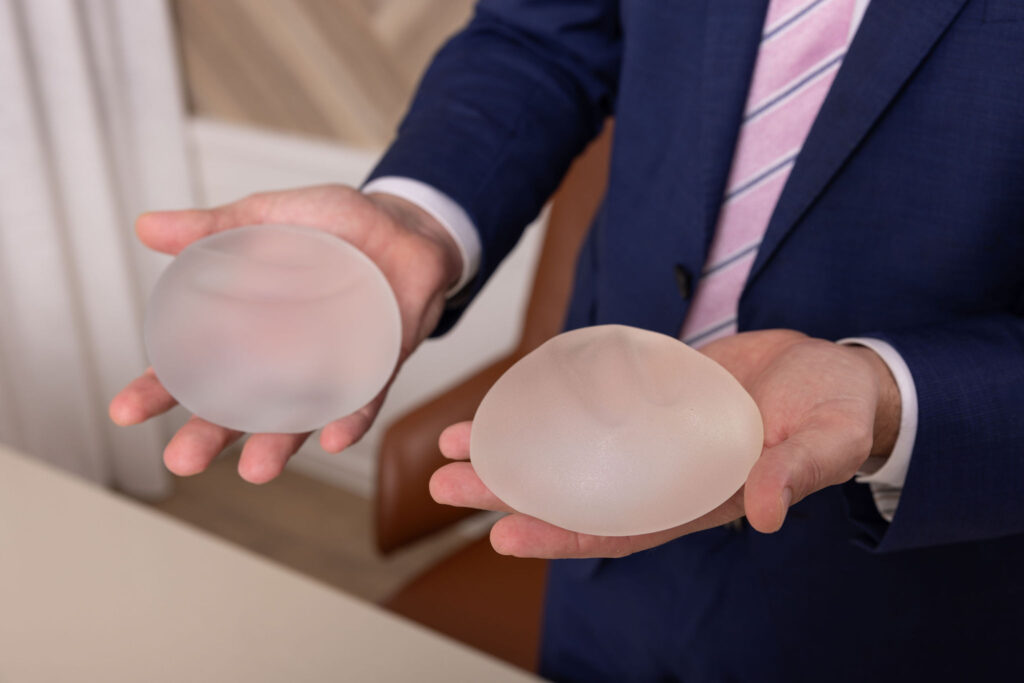
Recovery & Aftercare
You will usually be discharged home from hospital the same day. You are required to have someone pick you up from the hospital and remain with you for the first 24hours. You will be placed in a surgical bra which is to be worn at all times for the first 6weeks. Surgical garments provide compression to the site and assist in reducing swelling and support healing.
You will usually be discharged home from hospital the same day. You are required to have someone pick you up from the hospital and remain with you for the first 24hours. You will be placed in a surgical bra which is to be worn at all times for the first 6weeks. Surgical garments provide compression to the site and assist in reducing swelling and support healing.
Pain managed with prescribed medications; rest and limited activity is recommended for the first week.
You will have an initial review with our nurse during the first post-operative week, and at each week until your incisions are healed and your pain has resolved. 6 weeks post-operatively you will have a review with Dr Cronin. Regular follow -ups with Dr Cronin at 3months, 6 months and 12months are also essential to monitor your surgical outcome.
Patients should avoid strenuous activities and heavy lifting for the first few weeks post-operatively. Light activities can typically be resumed within a week. Dr Cronin will advise you if it is safe to resume exercise during your 6week review.
Keep incision sites clean and dry. Patients are advised on proper scar care techniques to minimise scarring. We offer a scar treatment plan for all of our surgical patients.
Be alert for signs of infection or unusual changes and call the clinic if you have any concerns.



Explant Surgery Before and After Gallery
Individual results will vary from patient to patient and according to factors including genetics, age, diet, exercise. All invasive surgery carries risk and requires a recovery period and care regime. Be sure you do your research and seek a second opinion from an appropriately qualified Specialist Plastic Surgeon before proceeding. Any details are general in nature and are not intended to be medical advice or constitute a doctor-patient relationship.
For comprehensive information on the potential risks and post-surgery recovery process, please see risks associated with surgery section towards the bottom of this page.
Removal of implants after an implant rupture
Frequently Asked Questions
The decision to undergo breast augmentation after a history of breast cancer should be made on an individual basis in consultation with your oncologist and a certified plastic surgeon such as Dr Drew Cronin with experience with breast reconstruction. There are several factors to consider, including the type and stage of breast cancer.
An en bloc capsulectomy is performed when the entire capsule is removed as a single specimen, with the undisturbed implant still inside, the procedure is referred to as an ‘En-Bloc’ dissection.
Dr Cronin cannot guarantee an en bloc capsulectomy due to a variety of reasons. Implants that have been placed behind the pectoralis muscle can sometimes be difficult to remove as an En-Bloc dissection, particularly if the capsule is thin and right up against the ribs. There are numerous reported cases of significant injury and harm caused to patients by the aggressive attempt to remove the breast implants as part of an En-Bloc when deemed inappropriate.
It is always important to discuss with your surgeon the balance of risks and benefits with En-Bloc dissection in your particular circumstances.
Yes, you can have fat grafting performed when your breast implants are removed. Fat grafting, also known as fat transfer, involves taking fat from another part of your body (such as the abdomen or thighs) and injecting it into your breasts to restore volume and improve contour. This procedure can be done simultaneously with implant removal.
It’s important to discuss your goals and suitability for fat grafting with Dr Cronin during your consultation.
You will be required to stop smoking or vaping at least 6 weeks before and after your surgery. This is important because smoking and vaping has been shown to significantly affect patient’s post-operative recovery and will potentially compromise your surgical outcome.
Dr Cronin will also advise you during your consultation if you are required to stop certain medications.
Breast Implant removal is a medical procedure and therefore has a medicare item number. To qualify for the medicare rebate, it is a requirement to get a referral from your GP to Dr Cronin and send it through to our clinic email admin@thecoastalclinic.com.au prior to your consult with Dr Cronin.
Before your consultation with Dr Cronin ensure you consider when you would like to have your surgery. You will need to consider:
- When you can take time off work to recover. Allow 1-2weeks (depending on your job)
- Ensure you have adequate support at home to assist if you have children.
- You will also need someone to drive you home and assist you during the initial recovery period. It is a requirement during the first 24 hours after your surgery that someone is present with you.
To qualify for the medicare rebate you must have a referral from your GP and you must meet the criteria. If you are eligible, Medicare will cover some of your surgical fees. You will still incur out of pocket expenses. Dr Cronin will discuss this during your consultation.
There are three types of breast implant surfaces available.:
Smooth breast implants have a smooth, non-textured surface. They move feely within the breast pocket and feel very soft. However they have been found to have a higher risk of capsular contracture and rupture.
Nano-textured implants have a very fine, uniform texture created using advanced manufacturing techniques. They are most commonly used by Dr Cronin as the fine texture promotes better tissue integration, helping to stabilise the implant and reduce the likelihood of movement or rotation. There is also a reduced risk of capsular contracture compared to smooth implants.
Textured– Micro textured breast implants have a more pronounced and rougher surface which improves the stability of the implant. Micro-textured implants have also been shown to reduce capsular contracture compared to smooth breast implants. Macro textured implants are no longer available in Australia.
During your consultation with Dr Cronin, he will suggest the most appropriate implant type for you.
The added volume and weight of a breast implant will contribute, over time, to the stretching of the skin and descent of the breast. For these reasons, most patients undergoing explant surgery would benefit from a procedure that removes the excess skin, re-shapes the breast, and re-positions the nipple in its original position, or mastopexy.
Patients that require a mastopexy in the same procedure will typically have a ‘Wise Pattern’ or ‘Anchor’ scar, involving a scar that runs around the outside of the areolar, a vertical scar that runs from the areolar down to the fold, and a third that runs along the fold.
At The Coastal Clinic we offer patients a Scar Treatment Plan for all surgical patients.
With explant alone, the scar is usually under the breast, extending the scar of the initial implant procedure. Breast implants are usually placed through an incision approximately 4-5cm long, but their removal requires an incision about twice as long.
At The Coastal Clinic we offer patients a Scar Treatment Plan for all surgical patients.
The cost of your explant surgery will depend on whether or not you are replacing your implants and if a mastopexy and/or fat grafting is required.
A detailed quote will be provided after your consultation with Dr Cronin detailing the costs for the surgical fees, any device, implant and garments used during your procedure and estimated hospital fees. We will provide you with the contact details for the anaesthetist who will provide you with a separate quote for your surgery.
The cost of your procedure includes:
- Dr Cronin’s surgical fees
- Hospital fees (estimate only)
- Two surgical garments
- All post-operative appointments with our Nurse
- All post-operative follow up appointments with Dr Cronin
- Two LED Heallite sessions at The Coastal Clinic Aesthetics located at Varsity Lakes
- A 6week post operative pack which includes the Strataderm
Risks of Surgery
As part of our commitment to delivering exceptional patient care, we aim to provide you with comprehensive information regarding the general risks associated with surgical procedures, anaesthesia, and procedure-specific risks.
- Acute medical event: Heart or lung complications (e.g. heart attack, stroke, chest infection)
- Death
- Deep Vein Thrombosis (DVT) or Pulmonary Embolisms (PE)
- A sore throat/breathing difficulty due to the general aesthetic or the endotracheal tube, which can cause swelling, noisy breathing or discomfort
- Short-term nausea following general anaesthesia
- Wound infection, which may result in treatment with antibiotics or further treatment/surgery. This is more likely in a smoker or a person with diabetes.
- Heavy bleeding from the wound, which may result in further treatment/surgery
- Wound discharge
- Poor or slow healing of the skin; wound breakdown; skin necrosis
- Wound dehiscence (wound ruptures along the surgical incision)
- Bruising and swelling. This will start to subside in one to two weeks but can take up to several months to settle
- Abscess/Haematoma/Seroma/Oedema
- Pain and discomfort
- Allergic reaction to sutures, dressing, antiseptic solutions
- Altered or loss of sensation in and around the treated area, which may persist for some months, numbness maybe permanent
- Adverse scarring
- Revisionary surgery
- Psychological impact of change in appearance
- Unsatisfactory cosmetic appearance
- Loss of nipple sensation
- Parasthesia (may be numbness or tingling)
- Asymmetry
- Inability to breast feed
- Puckering at wound edges
Seroma - Extended Drainage period
- Loss of nipple sensation
- Parasthesia (may be numbness or tingling)
- Asymmetry
- Capsular contracture
- Infection
- Reoperation
- Rupture of implants
- BIA- ALCL
- Rotation of implants
- Migration of implants




